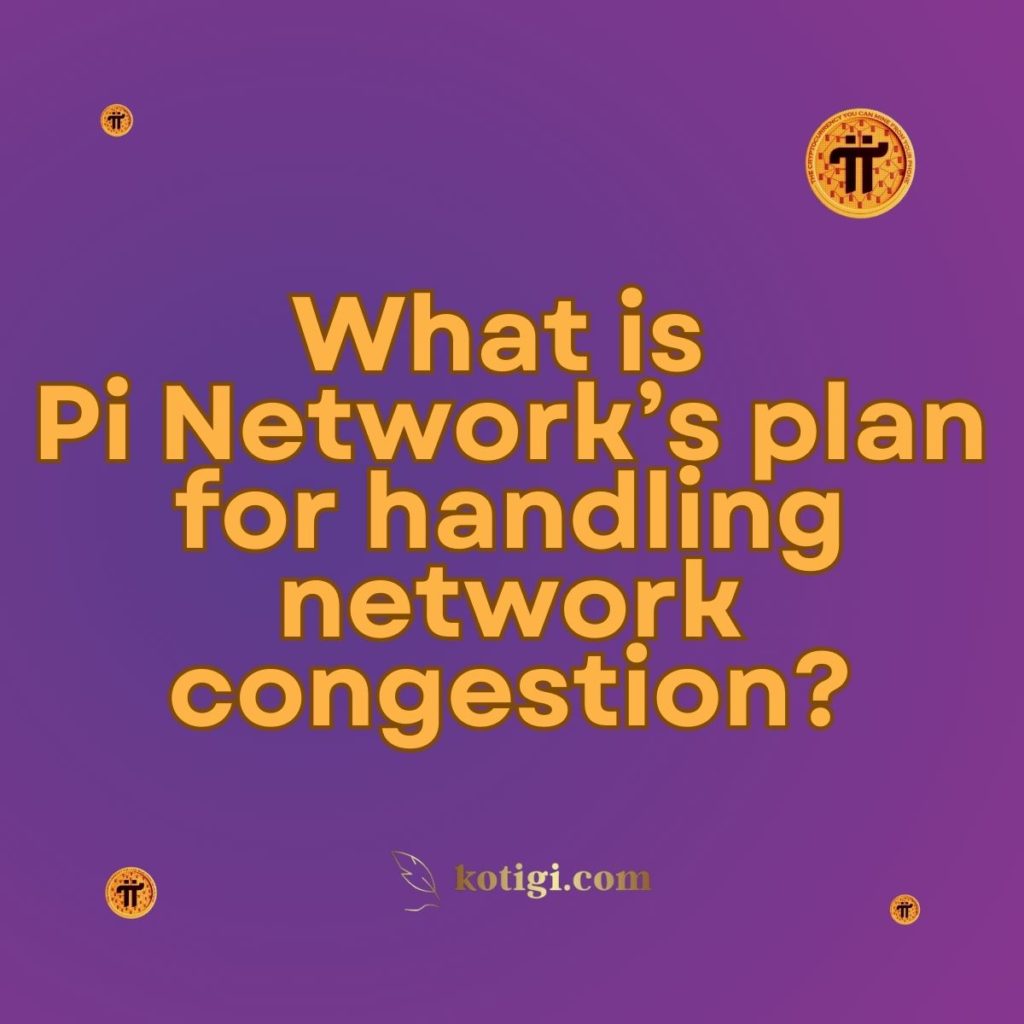
What is Pi Network’s plan for handling network congestion?
Pi Network is actively working on strategies to address network congestion, which is essential for maintaining a smooth user experience as the platform grows. With the increasing number of users and transactions, it becomes vital to implement effective measures to enhance the network’s capacity and efficiency. This article delves into Pi Network’s plans for managing network congestion, including its consensus mechanism, scaling solutions, and community-driven initiatives.
Introduction
As the Pi Network continues to expand its user base and functionalities, addressing network congestion has become a paramount concern. Network congestion can lead to slower transaction times, reduced efficiency, and an overall negative user experience. To ensure that Pi Network remains a viable platform for cryptocurrency transactions and decentralized applications, it is crucial to have a robust plan in place to manage congestion effectively. This article explores the various strategies Pi Network is implementing to handle network congestion, including its unique consensus mechanism, scalability solutions, and the role of the community in maintaining a seamless network experience.
1. Understanding Network Congestion
Network congestion occurs when a network becomes overloaded with more transactions than it can handle. This situation can lead to delays in transaction confirmations, increased fees, and a degraded user experience. As Pi Network aims to facilitate a large number of users and transactions, understanding the factors contributing to network congestion is essential for developing effective solutions.
1.1 Causes of Network Congestion
Several factors can contribute to network congestion in blockchain systems. High transaction volumes, limited network capacity, and the complexity of smart contracts are some common causes. In the case of Pi Network, as user adoption increases, the demand for transactions and interactions on the network will also rise, potentially leading to congestion issues if not managed properly.
1.2 Impact of Network Congestion
The impact of network congestion can be significant. Users may experience delays in transaction processing, leading to frustration and dissatisfaction. In addition, congestion can result in higher transaction fees as users compete to have their transactions prioritized by miners or validators. Ultimately, unresolved congestion issues can hinder the overall growth and acceptance of the network, making it essential for Pi Network to implement proactive measures.
2. Pi Network’s Consensus Mechanism
Pi Network employs a unique consensus mechanism that plays a crucial role in handling network congestion. Unlike traditional Proof of Work (PoW) or Proof of Stake (PoS) models, Pi Network’s consensus algorithm aims to provide a more efficient and scalable solution.
2.1 The Stellar Consensus Protocol
Pi Network’s consensus mechanism is based on the Stellar Consensus Protocol (SCP). SCP is designed to allow for faster transaction confirmations and improved scalability. By leveraging a federated Byzantine agreement model, Pi Network can achieve consensus without relying on extensive computational resources, making it more energy-efficient and accessible for users.
2.2 Efficiency and Scalability
The SCP enables Pi Network to process transactions more efficiently, reducing the likelihood of congestion during peak usage times. This efficiency is particularly crucial as the network scales and attracts more users. The consensus mechanism ensures that transactions are validated quickly, maintaining a smooth experience for users while minimizing the risk of congestion.
2.3 User Participation
Another aspect of Pi Network’s consensus mechanism is its emphasis on user participation. Users contribute to the network’s security and validation processes through the mining of Pi coins. This participatory model not only enhances security but also helps distribute the network load more evenly, reducing the risk of congestion during high-traffic periods.
3. Scalability Solutions
To further enhance its capacity and handle network congestion effectively, Pi Network is exploring various scalability solutions. These solutions aim to increase the throughput of transactions while maintaining the integrity and security of the network.
3.1 Layer 2 Solutions
One of the primary scalability strategies for blockchain networks is the implementation of Layer 2 solutions. These solutions operate on top of the base blockchain layer, allowing for faster and cheaper transactions without congesting the main network. Examples of Layer 2 solutions include state channels, sidechains, and rollups. Pi Network is actively researching the feasibility of such solutions to enhance its scalability.
3.2 Sharding
Sharding is another promising technique for improving scalability. This method involves splitting the blockchain into smaller, manageable segments called shards. Each shard can process its transactions independently, increasing the overall throughput of the network. By implementing sharding, Pi Network could effectively distribute the transaction load, minimizing congestion and enhancing performance.
3.3 Optimizing Transaction Processing
In addition to implementing external scalability solutions, Pi Network is focused on optimizing its transaction processing mechanisms. By improving the efficiency of how transactions are validated and executed, the network can better handle increased volumes without succumbing to congestion.
4. Community Engagement and Feedback
Pi Network recognizes that its community plays a vital role in identifying and addressing network congestion issues. By engaging with users and soliciting feedback, the network can continuously improve its strategies and solutions.
4.1 User Feedback Mechanisms
To gather insights from users, Pi Network has established feedback mechanisms, including surveys, forums, and community discussions. By understanding user experiences and pain points, the network can identify areas that require attention and implement targeted solutions.
4.2 Developer Collaboration
Collaboration with developers is another key aspect of Pi Network’s approach to handling congestion. By fostering a developer-friendly environment, Pi Network encourages the creation of innovative applications and solutions that can help alleviate congestion. Developers can propose optimizations and contribute to the overall improvement of the network’s performance.
4.3 Community-Driven Initiatives
Pi Network encourages its community members to participate in initiatives aimed at addressing congestion. This may include organizing events, hackathons, or workshops focused on developing solutions for network performance. By empowering the community to take an active role, Pi Network can tap into the collective knowledge and creativity of its users.
5. Monitoring Network Performance
Continuous monitoring of network performance is essential for identifying congestion issues and implementing timely solutions. Pi Network employs various monitoring tools and techniques to keep track of its network’s health and performance metrics.
5.1 Performance Analytics Tools
Pi Network utilizes performance analytics tools to monitor transaction throughput, latency, and overall network health. By analyzing this data, the network can gain insights into congestion patterns and identify peak usage times, allowing for proactive measures to be taken.
5.2 Real-Time Monitoring
Real-time monitoring allows Pi Network to detect congestion as it occurs. By implementing alerts and notification systems, the network can respond quickly to emerging issues, ensuring that users experience minimal disruptions.
5.3 Adjusting Resources Dynamically
Based on the monitoring data, Pi Network can adjust its resources dynamically to address congestion effectively. This may involve reallocating computational resources or optimizing transaction processing to accommodate higher loads during peak times.
6. User Education and Best Practices
Educating users about best practices can also play a significant role in mitigating network congestion. By empowering users with knowledge, Pi Network can foster a more efficient and responsible community.
6.1 Transaction Timing
Users can be encouraged to consider the timing of their transactions. During peak hours, when the network is likely to experience congestion, users may choose to delay non-urgent transactions. This can help distribute the transaction load more evenly throughout the day.
6.2 Optimizing Transaction Sizes
Educating users about optimizing transaction sizes can also contribute to reducing congestion. Users can be encouraged to bundle smaller transactions into larger ones when possible, minimizing the overall number of transactions processed on the network.
6.3 Awareness of Network Status
Keeping users informed about the network’s status and congestion levels can help them make informed decisions about when to transact. Pi Network can provide updates through social media channels, newsletters, or in-app notifications to keep users aware of potential congestion periods.
7. Future Innovations and Developments
As Pi Network continues to grow, it is essential to stay ahead of potential congestion challenges. The network is actively exploring innovative technologies and developments to enhance its capacity and performance.
7.1 Emerging Technologies
Emerging technologies, such as blockchain interoperability and advanced consensus algorithms, offer opportunities for Pi Network to improve its efficiency. By leveraging these technologies, Pi Network can enhance its scalability and reduce congestion risks.
7.2 Partnerships and Collaborations
Establishing partnerships with other blockchain projects and organizations can also facilitate knowledge sharing and collaboration on solutions to congestion. By working together, Pi Network can tap into a wider range of resources and expertise.
7.3 Continuous Improvement
Ultimately, Pi Network’s approach to handling network congestion is rooted in a commitment to continuous improvement. By regularly evaluating its strategies, incorporating user feedback, and exploring innovative solutions, Pi Network can ensure a smooth and efficient user experience even as it scales.
Conclusion
Pi Network is proactive in addressing network congestion to ensure a seamless experience for its growing user base. Through its unique consensus mechanism, scalability solutions, community engagement, and continuous monitoring, Pi Network is well-positioned to handle the challenges of increased demand. By focusing on user education and exploring future innovations, Pi Network can maintain its commitment to a decentralized and efficient cryptocurrency ecosystem.
Key Takeaways
- Understanding Network Congestion: Network congestion occurs when demand exceeds capacity, leading to delays and higher transaction fees.
- Unique Consensus Mechanism: Pi Network utilizes the Stellar Consensus Protocol to enhance efficiency and scalability, reducing the risk of congestion.
- Scalability Solutions: The network is exploring Layer 2 solutions and sharding to improve transaction throughput and minimize congestion.
- Community Engagement: User feedback and developer collaboration are critical in identifying and addressing congestion issues effectively.
- Monitoring and Dynamic Adjustments: Continuous monitoring of network performance allows Pi Network to respond to congestion proactively and dynamically adjust resources.
- User Education: Empowering users with knowledge about transaction timing and sizes can help mitigate congestion on the network.
- Future Innovations: Pi Network is committed to exploring emerging technologies and partnerships to enhance its performance and scalability.





